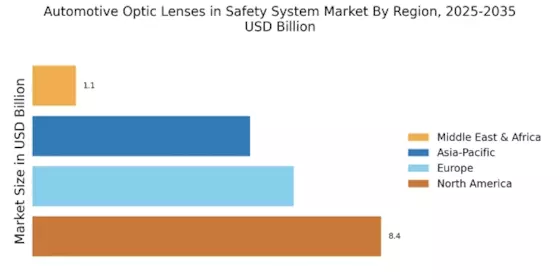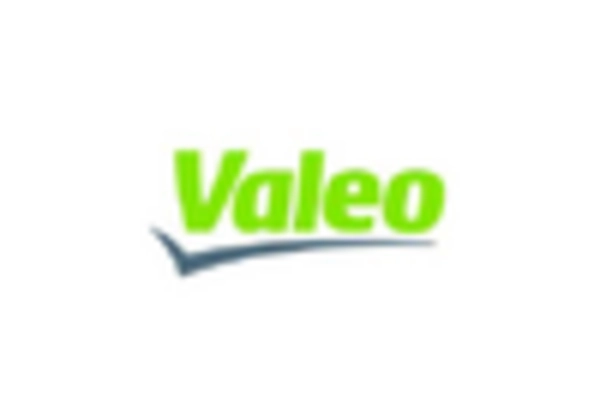Regulatory Compliance and Safety Standards
The Automotive Optic Lenses in Safety System Market is significantly influenced by stringent regulatory compliance and safety standards imposed by various authorities. Governments worldwide are mandating higher safety benchmarks for vehicles, which necessitates the integration of advanced safety systems, including high-performance optic lenses. This regulatory landscape is expected to drive market growth, as manufacturers must adapt to these evolving standards. For example, the implementation of new regulations regarding pedestrian detection systems has led to an increased focus on the quality of optic lenses used in these applications. As a result, the market is projected to expand, with an anticipated growth rate of 6% over the next few years, as companies strive to meet compliance requirements.
Rising Demand for Enhanced Safety Features
The Automotive Optic Lenses in Safety System Market is experiencing a notable surge in demand for enhanced safety features in vehicles. As consumers become increasingly aware of road safety, manufacturers are compelled to integrate advanced optic lenses that improve visibility and reduce accident rates. According to recent data, the market for automotive safety systems is projected to grow at a compound annual growth rate of approximately 8% over the next five years. This growth is driven by the need for better night vision and obstacle detection, which are critical for preventing collisions. Consequently, the incorporation of high-quality automotive optic lenses is essential for meeting these consumer expectations and regulatory standards, thereby propelling the market forward.
Integration of Smart Technologies in Vehicles
The integration of smart technologies in vehicles is transforming the Automotive Optic Lenses in Safety System Market. As vehicles become more connected and automated, the need for advanced optic lenses that support these technologies is becoming increasingly apparent. Features such as 360-degree cameras and augmented reality displays rely on high-performance lenses to function effectively. The market is projected to grow at a rate of 8% annually, driven by the increasing adoption of smart technologies. This trend not only enhances the driving experience but also significantly improves safety by providing drivers with real-time information about their surroundings. Consequently, the demand for innovative automotive optic lenses is expected to rise, further propelling market growth.
Consumer Preference for Advanced Safety Technologies
Consumer preference for advanced safety technologies is a pivotal driver in the Automotive Optic Lenses in Safety System Market. As vehicle buyers increasingly prioritize safety features, manufacturers are responding by equipping vehicles with state-of-the-art optic lenses that enhance safety systems. Surveys indicate that a significant percentage of consumers are willing to pay a premium for vehicles that offer superior safety technologies. This trend is likely to propel the market, with projections suggesting a growth rate of approximately 9% in the coming years. The demand for features such as lane departure warnings and automatic emergency braking systems, which rely heavily on high-quality optic lenses, underscores the importance of this driver in shaping market dynamics.
Technological Advancements in Optic Lens Manufacturing
Technological advancements in the manufacturing of automotive optic lenses are significantly influencing the Automotive Optic Lenses in Safety System Market. Innovations such as the development of adaptive lenses and improved coatings enhance the performance of safety systems. For instance, the introduction of lenses that can adjust to varying light conditions is becoming increasingly prevalent. This is particularly relevant as the automotive industry shifts towards more sophisticated safety technologies. The market is expected to witness a growth rate of around 7% annually, driven by these advancements. As manufacturers invest in research and development, the quality and functionality of optic lenses are likely to improve, further solidifying their role in enhancing vehicle safety.


















Leave a Comment